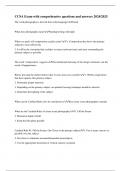Exam (elaborations)
Exam (elaborations) CCSA
- Course
- Institution
The word photography is derived from what language?️️Greek What does photography mean?️️Painting/writing with light What two goals will composition usually satisfy?️️1. Composition that shows the primary subjective most effectively 2. It will be the viewpoint that excludes as many i...
[Show more]



